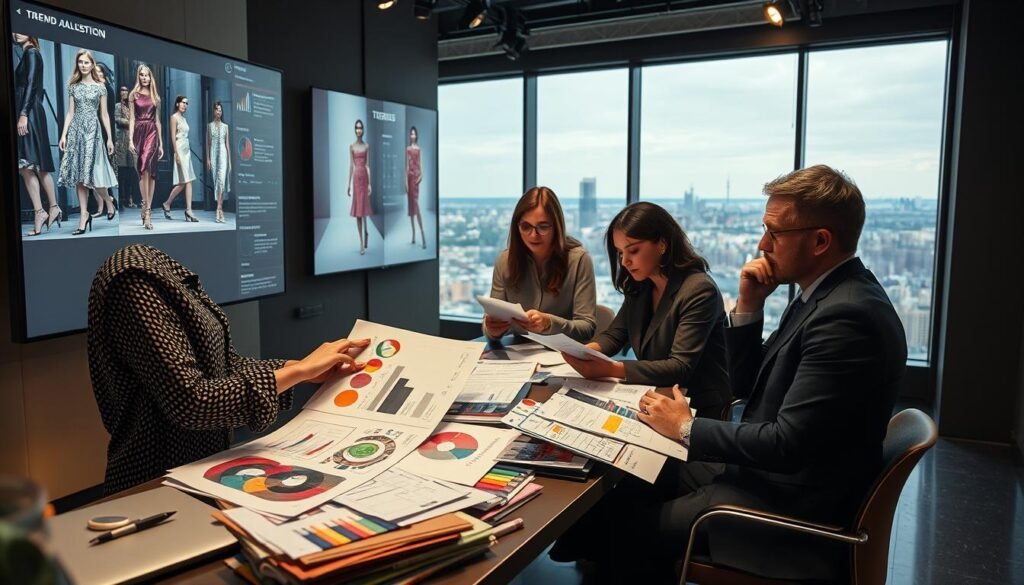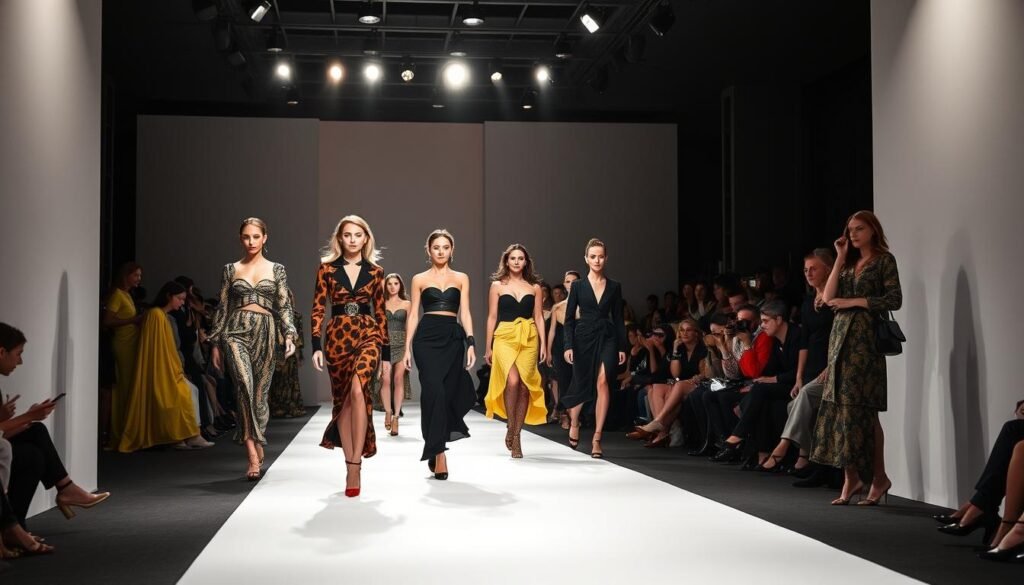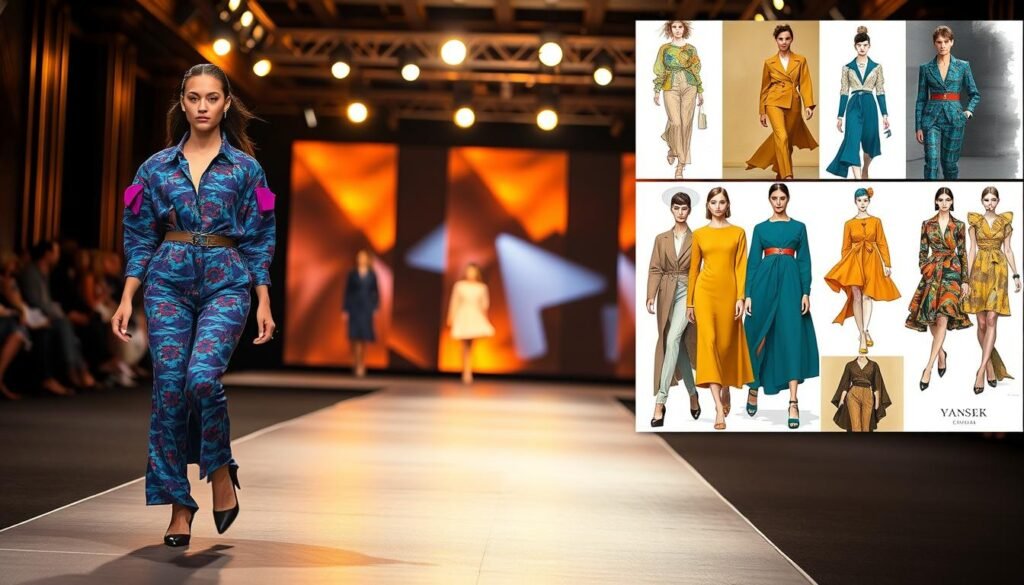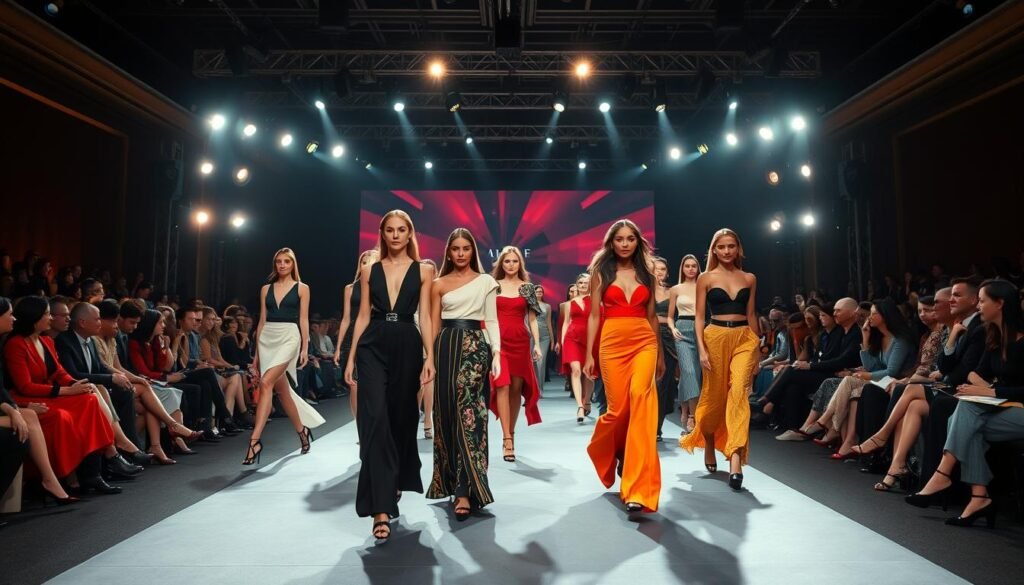“Fashion is not something that exists in dresses only. Fashion is in the sky, in the street, fashion has to do with ideas, the way we live, what is happening,” Coco Chanel once said. Her words are even more true today.
The world of designer fashion has changed a lot. Social media lets us see runway trends in new ways. Now, many voices shape what’s in style, not just magazines.
Fashion Week is full of creativity. But, the real challenge is figuring out which styles fit your life.
It’s not just about whether a look is cool on the runway. Ask yourself: “Can I see myself wearing this in six months? How about six years?”
This guide will show you how to make high-fashion looks work for everyday life. We’ll focus on creating styles that are true to you and last over time.
Key Takeaways
- Social media has democratized fashion, creating multiple trend influencers beyond traditional magazines
- Personal style develops through asking longevity questions about your wardrobe
- Runway looks need interpretation for everyday wear, not direct copying
- Sustainable fashion is about expressing yourself authentically, not following every trend
- The skill is in figuring out which designer elements fit your lifestyle
Understanding How Fashion Week Trends Emerge

Fashion week kicks off a six-month journey from idea to store shelves. Many players shape what ends up in your favorite stores. Knowing this helps you make better fashion choices and spot trends early.
The fashion world has changed a lot. Magazine editors used to decide what styles were popular. Now, social media lets influencers and regular people share their fashion opinions too.
Stylists like Allison Bornstein say it’s better to study each look closely. This is more useful than just looking at social media. Individual analysis shows the real value of new trends.
The Journey from Runway to Retail
It takes about six months for runway styles to hit stores. Fall collections start in February but show up in stores in August. This gives makers time to make clothes and stores time to plan.
Many important people help bring trends to stores. Buyers pick out pieces for their stores at fashion week. Fashion editors write about trends for magazines and websites. Trend forecasters look at many designers to guess what people will like.
Identifying Trends Worth Following
Not every trend is worth trying. Smart shoppers look for signs before buying new styles. Cross-designer consistency means a trend is likely to last.
Watch for trends that show up in many designers’ collections at once. These are signs of big changes, not just one designer’s idea. The best trends are versatile and fit with today’s lifestyle.
Think about your daily life and what you already wear. Trends that go well with your clothes offer more outfit options and save money.
Key Fashion Week Trends from New York, Paris, and Milan

The latest fashion shows have brought us four big runway trends to try. Designers have mixed style with comfort, making looks that stand out. These trends are great for updating your wardrobe without changing your style too much.
This season, you’ll see everything from bold colors to unique shapes. These trends offer new ways to refresh your style. They fit different lifestyles and comfort levels.
Bold Color Blocking and Neon Accents
Designers are using vibrant contrasts to make big statements. Balenciaga’s polka-dot dresses show how fun patterns can grab attention. The secret is to pick one bold piece to focus on.
Neon accents look best with neutral colors. Try a bright yellow bag with black clothes, or electric blue shoes with jeans and a white tee.
Oversized Blazers and Power Shoulders
Saint Laurent’s big bombers with shoulder pads are back. These structured pieces add style and confidence to any outfit.
Givenchy’s big coats show how outerwear can be the star. Just keep the rest of your outfit simple when wearing big tops.
Sheer Fabrics and Strategic Layering
Transparency trends need careful planning for everyday wear. Designers show how to layer see-through materials over solid bases.
This way, you can try the trend while staying comfortable. Try sheer sleeves over tanks or transparent skirts with solid linings.
Statement Sleeves and Dramatic Silhouettes
Runways were filled with big shapes and dramatic details. XXL coats and big sleeves turn simple outfits into showstoppers.
Looks inspired by school, with blazers and mini skirts, show how classics get a new twist. Pick one dramatic piece per outfit to avoid too much.
| Trend Category | Key Designer Examples | Styling Approach | Wearability Level |
|---|---|---|---|
| Bold Color Blocking | Balenciaga polka dots | One statement piece | High |
| Oversized Blazers | Saint Laurent bombers | Streamlined bottoms | Very High |
| Sheer Layering | Transparency collections | Strategic coverage | Medium |
| Statement Sleeves | Givenchy dramatic coats | Single focal point | Medium |
Step 1: Assess Your Current Wardrobe Against New Trends

Before jumping into fashion week trends, check what’s in your closet. This step stops you from making expensive mistakes. It helps you shop wisely. Think about what you like and if you’ll wear items in the future.
Looking at your clothes shows what you’re all about. You’ll find pieces that fit new trends and see what’s outdated.
Conducting a Closet Audit
Begin your wardrobe analysis by taking out all your clothes. Sort them into three piles: love it, maybe, and donate. This style assessment reveals your style and shopping habits.
Ask yourself about each item. Does it match the new styles? Can you style it in a fresh way? Think about its versatility, condition, and fit.
Don’t forget about basics like blazers, jeans, and neutral tops. These pieces often pair well with trendy accessories or bold items.
Identifying Gaps and Opportunities
Find areas where a few new items can refresh your look. Maybe you have great pants but need new tops. Or perhaps your accessories are out of date.
Look for pieces that can link your current style to new trends. This way, you build on what you already have, not start over.
Step 2: Choose Trends That Match Your Lifestyle

The secret to great style inspiration is to pick trends that fit your life. Runway shows are fun and dreamy, but not for everyday wear. Most designer looks are not made for daily life or body types.
Good trend analysis starts with fashion week ideas. Then, you need to make them fit your needs, body, and daily life.
Professional Environment Considerations
Your workplace culture affects which trends work for you. Creative jobs might like bold sleeves or big shapes. But, conservative offices need more subtle styles.
When dress codes are strict, add trendy colors with accessories. A bright handbag or bold jewelry can add style without breaking rules. You can also tone down statement sleeves with tailored blazers.
Personal Style Compatibility Assessment
Being honest with yourself helps avoid fashion mistakes. Think about how comfortable you are with bold pieces and how easy they are to care for.
Good lifestyle dressing picks trends that add to your style, not take over. Consider how versatile and long-lasting a trend is before you buy it.
| Lifestyle Factor | High-Maintenance Trends | Low-Maintenance Alternatives | Best For |
|---|---|---|---|
| Busy Professional | Sheer layering, complex patterns | Bold accessories, structured blazers | Quick morning routines |
| Active Lifestyle | Oversized silhouettes, delicate fabrics | Performance materials, streamlined cuts | Movement and comfort |
| Social Events | Statement sleeves, dramatic shapes | Trending colors, interesting textures | Versatile day-to-night wear |
| Budget-Conscious | Designer statement pieces | Trending accessories, color updates | Maximum impact per dollar |
Successful trend adoption is not about following every fashion rule. Choose what truly speaks to you and fits your life for lasting joy.
Step 3: Start Small with Trend-Forward Accessories
Make your everyday outfits pop with trend-forward accessories. They bring the latest looks to your wardrobe without breaking the bank. Small changes can make a big difference in how you look.
Try styling tricks like pushing sleeves up or tucking hair into your coat. These simple moves add sophistication without spending a dime. Thigh-high boots are back in style, showing that some accessories are always in fashion.
Statement Jewelry and Bold Hardware
Chunky chain necklaces and architectural earrings can update your wardrobe. A bold necklace can turn a simple blazer into a fashion statement. Big earrings can make a basic turtleneck stand out.
Mixing metals adds interest and keeps up with accessory trends. It’s important to balance bold pieces. Pick one standout jewelry item to keep your look in check.
Trending Handbag Styles and Colors
This season, mini bags and oversized totes are at opposite ends of the spectrum. Each style changes the mood of your outfit. Mini bags add a playful touch, while big bags show off your confidence.
Choosing the right handbag color is key for style updates. A trendy color sets the tone for your outfit. Bright colors can energize simple outfits, while classic colors ground bold ones.
Step 4: Incorporate Trending Colors and Patterns

Learning to mix colors and patterns can elevate your style. Recent fashion week shows have shown bold and unexpected pairings. For example, Prada and Miu Miu featured colorful sock-and-shoe combos, while Balenciaga showcased polka-dot dresses.
These runway moments show how strategic color and pattern choices can add interest without overwhelming your style.
Working with This Season’s Color Palette
Current color trends from major fashion capitals offer new options for your wardrobe. Start by finding colors that match your skin tone and existing clothes. Add new colors through accessories or secondary pieces before making big color statements.
Begin with one trending color per outfit. This builds confidence and keeps your look balanced. Seasonal color palettes include bold and soft shades that work well together.
Mixing Prints Like a Fashion Week Pro
Pattern mixing becomes easier with formulas from recent runway shows. Pair large patterns with smaller ones. Try mixing stripes with florals or geometric prints with polka dots, as seen in current collections.
Keep one element consistent, like color or theme. This creates cohesion while keeping your look dynamic and exciting.
Balancing Bold Choices with Neutrals
Pair trend-forward pieces with classic neutrals for sophisticated outfits. Let one bold pattern or bright color be the focus. Use black, white, beige, or navy for the rest of your outfit.
This approach makes your fashion week inspired looks wearable for everyday. Strategic neutral placement lets bold elements shine while keeping your outfit balanced and comfortable.
Step 5: Master the Art of Layering Trending Pieces
Learning layering techniques lets you add depth and interest to your outfits. It makes you look like you’re wearing the latest trends. The secret is knowing how to mix textures, weights, and sizes.
Fashion weeks show how to layer with transparency and cut-outs. Designers mix sheer fabrics with structured pieces for striking contrasts. This opens up many ways to express yourself through fashion.
Creating Depth with Textures and Fabrics
Using different fabric weights adds interest to your outfits. Try pairing smooth silk blouses with wool blazers for a cool contrast. Or layer lace over cotton for a unique look.
The transparency trend works well when done right. Wear sheer tops over camisoles with high-waisted pants. Add leather accessories to soft knits for a bold look.
The best layering isn’t about wearing more. It’s about choosing pieces that highlight your best features.
Proportional Balance in Layered Looks
It’s important to balance your silhouettes. Wear oversized blazers with fitted bottoms and structured accessories. This keeps your look stylish and on-trend.
Think about length when layering. Crop tops look great under longer jackets. Pair midi skirts with cropped sweaters and big coats for a chic look.
| Base Layer | Middle Layer | Outer Layer | Result |
|---|---|---|---|
| Fitted Camisole | Sheer Blouse | Structured Blazer | Professional Chic |
| Turtleneck | Slip Dress | Oversized Cardigan | Casual Elegance |
| Basic Tee | Button Shirt | Leather Jacket | Edgy Cool |
| Tank Top | Mesh Top | Cropped Jacket | Trendy Modern |
Step 6: Shop Strategically for Trending Items
Building a trendy wardrobe doesn’t have to be expensive. Smart buying means looking at trends carefully and buying at the right time. The fashion world makes spring-summer clothes in fall and winter in spring. This gives you time to see if you like a trend before buying.
High-Street Alternatives to Designer Pieces
You don’t need designer labels to look good. Focus on key design elements like shape, color, and special details. Stores like Zara, H&M, and COS make high-end looks affordable.
Look for quality in your clothes. Good seams, proper lining, and thick fabric mean your clothes will last. They’ll stay looking good for many seasons.
Investment vs. Trend Pieces Decision Making
Knowing when to spend more and when to save is key to smart shopping. Here’s a guide to help you make better choices:
| Investment Worthy | Trend Piece | Key Indicators |
|---|---|---|
| Classic blazers with trending details | Statement sleeves | Timeless base + trend accent |
| Quality leather accessories | Neon colors | Versatility across seasons |
| Well-made coats | Extreme proportions | Construction quality |
| Premium denim | Novelty prints | Personal style alignment |
Timing Your Purchases for Best Value
Use the six-month runway-to-retail timeline for the best trend analysis. Buy full-price items early in the season for more wear. Wait for sales at the end of the season for next year’s trends.
The best time to buy trendy pieces is when you’ll get the most wear out of them, not necessarily when they’re cheapest.
Plan your buys around fashion calendars. Spring clothes come in February, and fall in August. This way, you’ll wear trends when they’re most relevant.
Step 7: Style Your New Pieces for Maximum Impact
Mastering fashion styling means making every piece work hard in your wardrobe. Fashion shows give style inspiration, not exact plans. Your goal is to capture the runway’s essence while making it fit your life and body.
Smart styling turns one piece into many outfits. This way, you get more value and keep your style true to you.
Day-to-Night Transition Techniques
Creating outfit versatility means choosing wisely for different times. Start with a trendy piece, then change accessories and fit for the event.
For example, wear an oversized blazer with tailored trousers and simple jewelry for work. Change to sleek pants, bold earrings, and a bright lip for night.
The trick is in layering and accessorizing, not changing whole outfits. Remove structured items, add flowing ones, or switch bags for a quick change.
Mixing Trendy and Classic Elements
Good fashion styling mixes new trends with timeless pieces. This makes your look fresh but not forced.
Pair trendy statement pieces with classic basics. Try a dramatic top with jeans and flats. Add a bold necklace to a classic white shirt and blazer.
The 70-30 rule is helpful: use 70% classic items and 30% trends. This keeps your look thoughtful and current with style inspiration.
| Base Piece | Day Styling | Night Styling | Classic Element |
|---|---|---|---|
| Statement Blazer | Tailored pants + minimal jewelry | Sleek trousers + bold accessories | Classic white shirt |
| Trending Top | Dark jeans + simple flats | Leather pants + heeled boots | Structured blazer |
| Bold Print Dress | Cardigan + comfortable shoes | Statement jewelry + heels | Neutral accessories |
| Oversized Sweater | Fitted pants + sneakers | Midi skirt + ankle boots | Tailored bottoms |
Transform Fashion Week Inspiration Into Your Signature Style
Trusting your instincts is key to blending trends into your style. Fashion week is a spark, not a strict guide for your clothes. It’s about finding what truly fits you.
When deciding on clothes, ask if you’ll wear them often. This question helps you choose what feels right, not just what’s trendy.
Choosing pieces that fit your style and challenge you is smart. It’s not about copying runway looks. It’s about making them your own.
People who always look great know how to make trends fit their life and body. They create styles that are both modern and personal.
Your style keeps changing with each new season. Enjoy the journey of making high fashion your own. Trust your feelings when you feel confident and excited.
Being true to yourself while staying current is the secret. Let fashion week trends spark your creativity. But never let them control how you see yourself.

